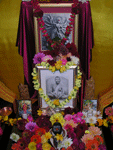Notes from Babaji’s classes in Portland
Saturday, September 27, 2008
Durga Puja Day: Teachings on the Divine Mother 
Babaji presented 3 charts:
Waves in the Ocean of Mature Universalism
The Three Gunas of Nature
Prakasha Shakti, The Revealing Power
In true spiritual life one must be able to switch gears — from the Advaitic to the Tantric, from inward yoga to external karma. A car doesn’t run smoothly if one fails to shift speeds accordingly. So, you should be able to step from Advaita, the nondual perspective that detaches from all name and form, to Tantric deification of form — without skipping a beat. And know that form can give way to formlessness — this also should be “substitutable.” Sri Ramakrishna expressed his ideal of universalism using the analogy of cows out in the pasture. There, they all mix together in a friendly manner, but at night they each have their own stall. He therefore meant that His devotees should be able to live with those of all spiritual traditions. Still, you have your own stall. That means you have your own Ideal. But it doesn’t mean you can’t partake of the wisdom of other ideals. “Share the Road” as the signs say in Portland, Oregon. In true universalism, the Deities become interchangeable. There is the personal Deity, and then there is Its nondual or formless “counterpart” that is identical with those of all other deities: Shiva/Paramashiva; Vishnu/Mahavishnu; Shakti/Mahashakti, who is one with Brahman; who dances on Shiva. The Great Master stated, “If I hadn’t searched for God in every religion, then I wouldn’t have had any peace of mind.”
